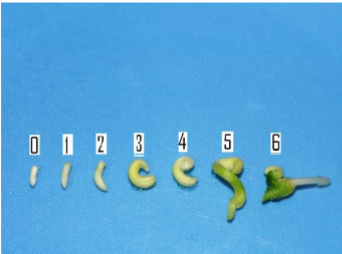In vitro embryo rescue of interspecific hybrids of oil palm (Elaeis oleifera x Elaeis guineensis)
DOI:
https://doi.org/10.20873/jbb.uft.cemaf.v2n2.alvesPalabras clave:
vegetable oil, zygotic embryos, genetic breedingResumen
The oil palm (Elaeis guineennsis Jacq.) is the plant with major oil yield in tropical areas over the world. Pará state is the major producer of Brazil. However, the production of resistant hybrids (Elaeis oleifera x Elaeis guinennsis) to several diseases is necessary, in spite of less productive, is a viable alternative for areas where occur more aggressive diseases. The aim of this research was to rescue in vitro embryos of four varieties of interspecific hybrids of oil palm (Elaeis oleifera x Elaeis guineensis) in different media. Four varieties were tested: (1) Cj-2141; (2) CI-2061; (3) Cj-502 and (4) Cj-494. Four media were tested: (T1) half strength MS medium (½ MS), (T2) MS, (T3) MS + 0.5mg L-1 1-naphthaleneacetic acid (NAA) and 6-benzylaminopurine (BAP) and (T4) ½ MS+ 0.5mg.L-1 NAA and BAP. All media were supplemented with 0.17g.L-1 NaH2PO4, activated charcoal (0.25%), sucrose (3%) and solidified with phytagel (0.2%). The most germination rate of interspecific hybrids embryos was obtained on ½ MS medium, supplemented with 0.17g.L-1 NaH2PO4, activated charcoal (0.25%), sucrose (3%) and solidified with phytagel (0.2%). The variety CI-2061 presents the best capacity to develop normal seedlings.
Citas
Alves, S. A. O. Regaste de híbridos interespecíficos de dendezeiro (Elaeis oleifera x Elaeis guineensis). Dissertação (Mestrado em Botânica) -Universidade Federal Rural da Amazônia/Museu Paráense Emilio Goeldi, 2007.
Asano, Y.; Imagawa, M. (1999), Hybrid seed formation among Dioscorea opposita Thunb. cvs. Nagaimo, Ichoimo, Tsukuneimo and Dioscorea japonica Thunb. Journal of the Japanese Society for Horticultural Science, 68, 591-597.
Cavalcante, A. S. L. Respostas morfogenéticas in vitrode açaizeiro(Euterpe oleracea L.) e de cupuçuazeiro (Theobrama grandiflorum (Wild. Ex Spreng) Schum). Tese (Doutorado em Fitotecnia)-Universidade Federal do Ceará,2001.
Carvalho, A. V.; Alves, B. J. R.; Reis, V. M. (2006), Resposta do dendezeiro à adição de nitrogênio e sua influência na população de bactérias diazotróficas. Pesquisa Agropecuaraia. Brasileira, 41, 293-300.
Cruz, C. D.; Regazzi, A. J. (2001), Modelos biométricos aplicados ao melhoramento genético. 2a. Ed. Viçosa: Universidade Federal de Viçosa, 390p.
Fantini Junior, M. and Graça, M. E. C. Propagação in vitrode Eucalyptus saligna (1990), In: Congresso Florestal Brasileiro. Anais: São Paulo: Sociedade Brasileira de Silvicultura, 373-378p.
Islam, M. M.; Wahed, S. A.; Khan, S. A. K. U. (2004), Studies on callus induction and regeneration from dehulled rice (Oryza sativaL.) seeds. Plant Tissue Culture and Biotechnology,14, 155-160.
Khatun, M. M.; Ali M. H.; Desamero, N. V. (2003), Effect of genotype and culture media on callus formation and plant regeneration from mature seed scutella culture in rice. Plant Tissue Culture and Biotechnology, 13, 99-107.
Kanchanapoom, K.; Domyoas; P. (1999), The Origin and Development of Embryoids in Oil Palm (Elaeis guineensisJacq.) Embryo Culture.Science Asia, 25, 195-202. Lemos, O. F. P. Mutagênese e tecnologia in vitrono melhoramento genético de pimenta-do-reino (Piper nigrumL.). Tese (Doutorado em Agronomia). Escola Superior de Agricultura “Luiz de Queiroz”, Universidade de São Paulo, 2003.
Murashige, T. and Skoog, F. (1962), Revised medium for rapid growth and bioassays with tobacco tissue culture. Physiologia Plantarum, 15, 473-497.
Silva, V. S. Regeneração in vitrode embriões de Cocos nuciferaL. Dissertação (Mestrado em Ciências).Escola Superior de Agricultura “Luiz de Queiroz”, Universidade de São Paulo, 2002.
Surre, C.; Ziller, R. (1969), La palmera de aceite. Barcelona: Ed. Blume (Coleccion Agricultura Tropical), 231p.
Teixeira, J. B.; Söndahl, M. R.; Kirby, E. G. (1993), Somatic embryogenesis from immature zygotic embryos of oil palm. Plant Cell Tissue and Organ Culture, 34, 227-233.
Viegas, I. de J. M. andMuller, A. A. (2000), A cultura do dendezeiro na Amazônia brasileira. Belém: Embrapa-Cpatu; Manaus: Embrapa-CPAA, 374p.

Descargas
Publicado
Cómo citar
Número
Sección
Licencia
Copyright (c) 2024 - Journal of Biotechnology and Biodiversity

Esta obra está bajo una Licencia Creative Commons Atribución 4.0 Internacional.
Los autores que publican en esta revista aceptan los siguientes términos:
Los autores mantienen los derechos autorales y conceden a la revista el derecho de primera publicación, con el trabajo simultáneamente licenciado bajo la LicenciaCreative Commons Attribution (CC BY 4.0 en el link http://creativecommons.org/licenses/by/4.0/) que permite compartir el trabajo con reconocimiento de la autoría y publicación inicial en esta revista.
Los autores tienen autorización para asumir contratos adicionales separadamente, para distribución no exclusiva de la versión del trabajo publicado en esta revista (ej.: publicar en repositorio institucional o como capítulo de libro), con reconocimiento de autoría y publicación inicial en esta revista.
A los autores se les permite, y son estimulados, a publicar y distribuir su trabajo online (ej.: en repositorios institucionales o en su página personal) en cualquier punto antes o durante el proceso editorial, ya que esto puede generar alteraciones productivas, bien como aumentar el impacto y la citación del trabajo publicado (disponible en El Efecto del Acceso Libre en el link http://opcit.eprints.org/oacitation-biblio.html).


